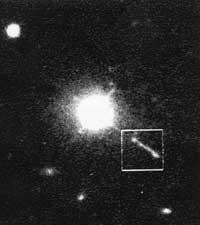Kuasares throw fire
The Hubble satellite is, as we know, a magnificent telescope launched to solve the mysteries of the universe. However, after the launch, they realized that due to some mistakes he had myopia and the astronauts returned to Earth on December 13, when this myopia had been repaired.
However, it has sent images to the repair of the Hubble Telescope, one of them being the Furnace 3C273. Located in a very distant part of the universe (3,000 million light-years), the photograph shows the launch of fire. Until now the astronomers knew that the quasars were blasting the matter outside, but it has never been possible to see optically and the photo will serve to know better the quasars.

The truth is that we do not know much about the quasars. It was in 1963 that the first was detected (3C273) and was very far away. Because of their similarity to the points of light they were called kuasare (derived from the English word quasistellar or “sasiizar”).
Considering that they are far away, you can say that they have enormous natural lighting. So far the physical phenomenon that is carried out to produce so much energy is unknown. Maybe it is influenced by black holes, but in any case they will be huge black holes of great mass.
Due to its great attraction, the central black hole absorbs all the matter from the environment, accelerating the particles and expelling the activity of the surrounding set. In the photo taken by the telescope you can see how the Kuasare throws matter into the fire.
As the radioastronomy data suggest, the quasi-release is not symmetrical, and being a one-way phenomenon, it can mean a propelling effect of the central mechanism. The flow of matter thus launched can reach almost the speed of light and extend to thousands of light years.
But it is interesting that the launch is not continuous. The plasma is periodically ejected and the black hole does not seem to function as a regular motor.
When in February the Hubble Telescope starts sending net images, we will be able to learn more about the remote Universe (therefore, the birth of the Universe).
Buletina
Bidali zure helbide elektronikoa eta jaso asteroko buletina zure sarrera-ontzian











